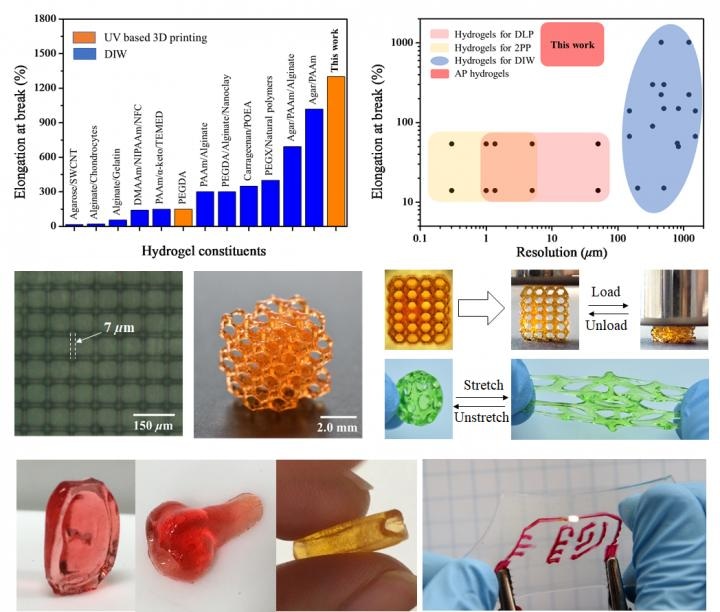Jun 1 2018
Hydrogels, hydrophilic networks of polymeric chains equipped to retain a large quantity of water, have been extensively used in a range of applications. Latest advances in extremely stretchable hydrogels have extended their applications into the fields of transparent touch panels, soft robotics, and other applications necessitating large deformation.
 Highly stretchable and UV curable 3D printing hydrogels that can be stretched by up to 1300% and are compatible with high-resolution digital light processing based 3D printing enabling the fabrication of hydrogel structures with complex geometries which can be applied to biomedical applications and flexible electronics. (Credit-Courtesy of Qi (Kevin) Ge)
Highly stretchable and UV curable 3D printing hydrogels that can be stretched by up to 1300% and are compatible with high-resolution digital light processing based 3D printing enabling the fabrication of hydrogel structures with complex geometries which can be applied to biomedical applications and flexible electronics. (Credit-Courtesy of Qi (Kevin) Ge)
However, traditional fabrication techniques, which mostly depend on molding and casting, restrict the possibility of applications because of the limited geometric complexity and the comparatively low fabrication resolution. Together with latest rapid developments in 3D printing, a number of attempts have also been made to use 3D printing to construct hydrogel structures with intricate geometries including porous scaffolds, vascular networks, meniscus substitutes and others. Nonetheless, current 3D printed hydrogels do not possess high geometric complexity, high printing resolution, as well as high stretchability, which make them incompatible for many applications.
Now, scientists from the Singapore University of Technology and Design (SUTD) Digital Manufacturing and Design (DManD) Centre and the Hebrew University of Jerusalem (HUJI) have developed a group of extremely stretchable and UV curable hydrogels that can be stretched by up to 1300%, and are ideal for UV curing based 3D printing methods. These have been accepted to fabricate hydrogel structures that require high geometric complexity and high printing resolution. Details of this research were reported in the April 2018 issue of Journal of Materials Chemistry B and it was also featured on the front cover.
"We have developed the most stretchable 3D printed hydrogel sample in the world," said Assistant Professor Qi (Kevin) Ge from SUTD's Science and Math Cluster, who is one of the co-leaders of this project.
The printed hydrogel sample can be stretched by up to 1300%. At the same time, the compatibility of these hydrogels with digital light processing-based 3D printing technology allows us to fabricate hydrogel 3D structures with resolutions up to 7 μm and complex geometries.
Qi (Kevin) Ge, Assistant Professor, Science and Math Cluster, SUTD
"The printed stretchable hydrogels show an excellent biocompatibility, which allows us to directly 3D print biostructures and tissues. The great optical clarity of these hydrogels offers the possibility of 3D printing contact lenses. More importantly, these 3D printable hydrogels can form strong interfacial bonding with commercial 3D printing elastomers, which allows us to directly 3D print hydrogel-elastomer hybrid structures such as a flexible electronic board with a conductive hydrogel circuit printed on an elastomer matrix," said Professor Ge.
Overall, we believe the highly stretchable and UV curable hydrogels, together with the UV curing based 3D printing techniques, will significantly enhance the capability of fabricating biostructures and tissue, contact lenses, flexible electronics, and many other applications.
Professor Shlomo Magdassi, Co-leader of this project, HUJI